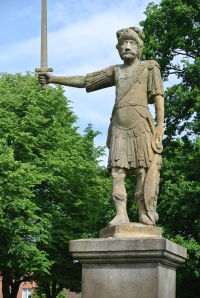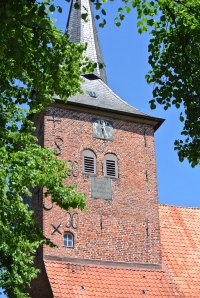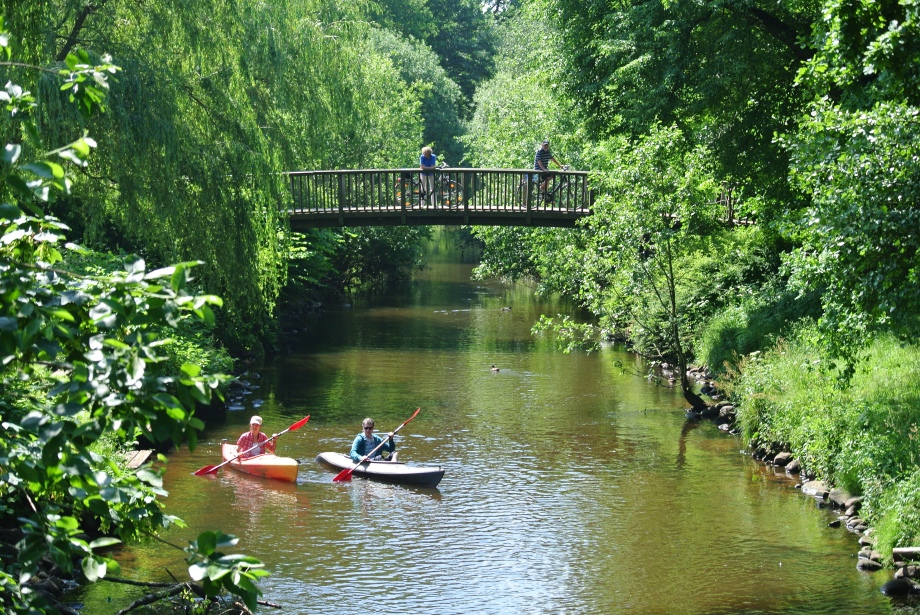 Bramstedt in 1850 was a rural centre of some 3000 people. The town had been prominent in the region for centuries for two reasons: it was an important stopover on an old cattle route for traders driving their herds from the Jutland peninsula south to continental Europe, and it was also an important resting place on an ancient monks route used by Christian pilgrims making their way from Glückstadt on the Elbe in the west to Puttgarden on the Baltic Sea in the east. Although the spring with healing properties (Gesundbrunnen) had been known since the 1600s Bramstedt did not gain fame as a health spa until the late 1800s and into the 1900s, long after Johan Holtorf had left. The name Bad Bramstedt (bad is a German word that in this context means spa) only came into use in the first decade of the twentieth century, and was given to the town to distinguish it from the nearby town of Barmstedt, because mail so often ended up in the wrong place!
Bramstedt in 1850 was a rural centre of some 3000 people. The town had been prominent in the region for centuries for two reasons: it was an important stopover on an old cattle route for traders driving their herds from the Jutland peninsula south to continental Europe, and it was also an important resting place on an ancient monks route used by Christian pilgrims making their way from Glückstadt on the Elbe in the west to Puttgarden on the Baltic Sea in the east. Although the spring with healing properties (Gesundbrunnen) had been known since the 1600s Bramstedt did not gain fame as a health spa until the late 1800s and into the 1900s, long after Johan Holtorf had left. The name Bad Bramstedt (bad is a German word that in this context means spa) only came into use in the first decade of the twentieth century, and was given to the town to distinguish it from the nearby town of Barmstedt, because mail so often ended up in the wrong place!
There are two landmarks of present day Bramstedt representing these aspects of the town, the economic and the spiritual. They are the so called Roland statue, and the Church of Mary Magdalene. The Roland statue is one of many similar statues in Germany, and it is a symbol of fairness in trading. There have been a succession of statues standing  on the same spot in the middle of Bramstedt for many centuries, but the one that is there now is, I believe, the same one that Johann would have seen every time he walked down the main street of his home town. It was erected in 1827, the year before Johann was born, replacing an older structure that had fallen down in 1814. The other landmark, the Church of Mary Magdalene (Maria Magdalenen Kirche) dates back to the 1200s. Johann’s father, Claus Holtorf, married twice in the church, the first time to Margarethe Köhnke, Johann’s mother, in 1817, and the second time to Elsabe Lentfer in 1837, two years after his first wife died. Johann was probably baptised in the church too, though I have not seen any document testifying to this.
on the same spot in the middle of Bramstedt for many centuries, but the one that is there now is, I believe, the same one that Johann would have seen every time he walked down the main street of his home town. It was erected in 1827, the year before Johann was born, replacing an older structure that had fallen down in 1814. The other landmark, the Church of Mary Magdalene (Maria Magdalenen Kirche) dates back to the 1200s. Johann’s father, Claus Holtorf, married twice in the church, the first time to Margarethe Köhnke, Johann’s mother, in 1817, and the second time to Elsabe Lentfer in 1837, two years after his first wife died. Johann was probably baptised in the church too, though I have not seen any document testifying to this.
Johann’s father, Claus, was a shoemaker as well as being a timber warden on one of the estates around Bramstedt. Market days were presumably an important part of the week for Claus Holtorf for this reason. However, the family probably didn’t move to Bramstedt until around the time Johann’s mother Margarethe died, when he  was just 7 years old. By then his oldest sister Anna was 18 and she would likely have taken on a great deal of the mothering duties in the family. Johann had two older sisters, Anna and Minna, and two older brothers, Claus and Hans. He also had a brother who was two years younger, Andreas. Johann and Andreas were both born in the little village of Bimöhlen, a few kilometres to the west of Bramstead. Anna, the first born, had also been born there but after her birth the family moved to another small village, a little further away, called Großenaspe. Johann and Andreas were born after they moved back to Bimöhlen sometime around 1827, and so their earliest years were lived there in the countryside. Bramstead probably seemed like a very big city to the little boys when they moved there around 1835.
was just 7 years old. By then his oldest sister Anna was 18 and she would likely have taken on a great deal of the mothering duties in the family. Johann had two older sisters, Anna and Minna, and two older brothers, Claus and Hans. He also had a brother who was two years younger, Andreas. Johann and Andreas were both born in the little village of Bimöhlen, a few kilometres to the west of Bramstead. Anna, the first born, had also been born there but after her birth the family moved to another small village, a little further away, called Großenaspe. Johann and Andreas were born after they moved back to Bimöhlen sometime around 1827, and so their earliest years were lived there in the countryside. Bramstead probably seemed like a very big city to the little boys when they moved there around 1835.
A river flows through the centre of Bramstedt and it would have been very familiar to the Holtorf children. It also became the scene of a family tragedy when Johann was a teenager. The river arises in the gentle hills of central Holstein and flows west through first Bimöhlen and then Bramstedt and onward toward the North Sea. However, the River Bram, or Bramau as it is called in German, never reaches that sea, but joins a larger waterway, the Stör River, which eventually empties into the Elbe, just north of Glückstadt. The Elbe is a huge waterway flowing north-west from Hamburg. Years later Johann would sail down this huge river and out into the North Sea on the first leg of his voyage to Australia.
When Johann was 9 his father remarried, this time to Elsabe Lentfer, who became Johann’s stepmother. Over the ensuing 7 years Elsabe had four sons, Johann’s half-brothers, though the second died shortly after birth. Elsabe’s first son Hinrich also died in childhood. In 1845 when Johann was 17 his little step-brother Hinrich drowned, quite possibly in the Bram River. He was only seven years old. Claus and Elsabe must have been heartbroken, not to mention the rest of the family, to lose the little boy so tragically.
Johann was 28 years old when he left Bramstedt in 1856 and sailed to Australia. What he did in his early adult life I don’t know. His father was a shoemaker, and a timber warden. It would be normal for a son to follow his father’s trade, but Johann had two older brothers and it is not certain that they would all have become shoemakers. More likely is that he worked in the forest and as an agricultural labourer. Probably on market days he helped with the sale of the family products. After he had moved to Australia Johann was a travelling salesman – a “hawker” as the family records put it (interestingly, the word hawker has its origins in Low German, the language that Johann spoke). Perhaps he learned that trade shouting out his father’s wares on the streets of nineteenth century Bramstedt.
